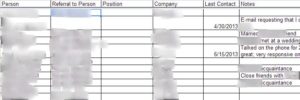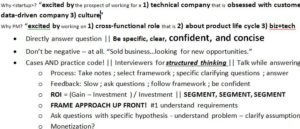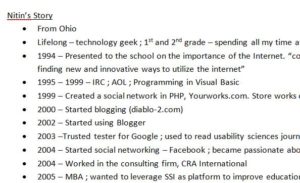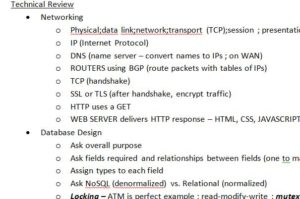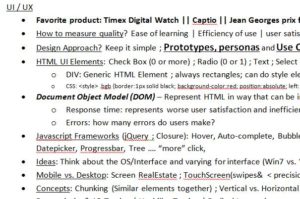Context
After six years of running an Ohio-based IT business, I was ready for a change. I wanted to work in Product Management at a rapidly growing, venture-backed startup in Silicon Valley. I had loved software technology my entire life, majored in Computer Science and Psychology as an undergrad, had an MBA, and 7 years of professional experience as a consultant, co-founder, and executive of a mid-sized business.
Over the course of the next 2 months, I called every friend, acquaintance, or friend of a friend possible to learn more about working in Product Management in the Valley. Some people told me I didn’t have a chance because I was attempting to change industries, roles, and geographies simultaneously.
Nonetheless, with the encouragement and support of my wife and daughter, I began a 5-week mission to find a job in the Valley. I crashed at friends’ apartments, bummed a spare desk at a former classmate’s office, and lived off cheap pizza and Mission burritos.
By the end of the 5 weeks, I had multiple job offers, including the one I accepted – as a Technical Product Manager at a rapidly growing venture-backed startup in the Valley.
Recommended book for Product Managers Hooked: How to Build Habit-Forming Products
Here are my key insights from this experience.
Company Target List Creation
To ensure the highest likelihood of success, I decided to cast a really, really wide net. My initial target list was ~60 companies. My process for the target list creation was to select ~20 VCs, and 2-5 companies per VC that looked interesting to me. Given that VCs fund a ton of companies, I probably read over 200 Crunchbase summaries and visited over 100 websites. For what it’s worth, here was what my company target list spreadsheet looked like:
Ineffective approach – over investing time in select companies
I probably invested 60-80 hours per company for the first 2-3 companies that I targeted. I read 10-Ks, 10-Qs, blog post, and about pages, and did product reviews while forming an opinion about the company’s strategies. I soon realized that I was over-investing time into the companies that I thought I was most excited by.
Connecting with Target Companies
My daily metric during my search was to get meetings, and not interviews. Once I arrived in San Francisco, my goal was to set up 3-5 meetings per day.
Using personal connections and 2nd degree LinkedIn connections, I started to set up as many meetings as I could. I also tried experimenting with LinkedIn ads.
The best sources of introductions were my graduate school network, friends from high school, friends from college, and friends from older jobs.
I spent a limited amount of time reaching out to a few recruiters and got traction with 1 company through that process.
Requesting Introductions
If I was asking someone for an introduction, I tried to be as respectful to the introducer as possible. I even drafted ghost-written e-mails for the introducer to send to my target, requesting the target’s permission, and another draft e-mail of the actual introduction. See samples below:
________________
In hindsight, it would have been better for me to directly send an e-mail to the introducer with why my target would be interested in me. As an example:
Meetings Structure
Once I got a meeting, my agenda was as follows:
- What do you do?
- How’d you get into (role) (with specific thoughtful questions/comments demonstrating I have done in depth research about them and the company)
- My story/background
- My goals
- Any advice?
- Do you know anyone at x companies?
- Anyone else I should talk to who is looking for Technical Product Managers?
I always brought the list of companies that I was targeting to the meetings and asked for suggested companies to add to my list. I also took detailed hand-written notes.
Immediately after the meeting, I sent a follow up e-mail recapping the conversation and next steps. I also kept the introducer updated on my conversations.
Tracking Meetings
I had a spreadsheet to keep track of who I was meeting and who introduced me to who. An example of this spreadsheet is below.
Interview Preparation
Practice Interview and Case Preparation
I tried asking as many Technical Product Manager friends or Consultant friends as possible to practice interview with me. They were probably sick of me asking them for help by the end of it.
For case interview preparation, I watched 6 hours of Victor Cheng’s Consulting Interview Preparation videos and read his website. I also attended workshops at General Assembly.
Interview Packet
In parallel, I created a 48-page set of personal interview notes. I did not use the notes during my interviews, but I believe the process of creating the notes helped crystallize several concepts in my head. An excerpt from P. 1 of my notes is below:
Summarize my Story
P. 2 was a bullet point summary of my story.
Technical Preparation
Even though I hadn’t coded in 8 years except for writing a few javascript scripts in Adwords, I wanted to get up to speed on as much technology as I could – NoSQL, Distributed Systems, Networking, etc. Therefore, I solicited the help of my friend, a former Google programmer, to give me a couple hour introductory tutorial on these topics. An excerpt of my notes is below:
I also read that interviewers will sometimes throw in technical programming questions. Therefore, I used Google Adwords Scripts as an IDE to re-teach myself some old sorting algorithms. This is P. 4 of my interview prep. I should probably be embarrassed of this code.
UI/UX Preparation
In terms of UX/UI, I tried googling free videos on design. I did not have any friends who were UI/UX designers, so I put a lot of this page together on my own.
Company Preparation
The next section of my preparation included pages on each of the companies I was interested in and a summary of:
- Why <company>?
- Biggest challenges facing <company>?
- How to improve <company>?
- What are the top promising products that failed at <company>?
Interview Question and Answer Preparation
The rest of the document consisted of me anticipating as many questions as I could and writing out my response to those questions. As some example questions:
- What are your favorite technologies?
- What are some products that you love?
- What are your top product ideas?
- What are your values?
- What are your career goals over 3-5 years?
- What is your product management experience?
- What metrics would you use to evaluate a product’s success?
- How would you promote a new product?
- What is your experience managing engineers?
- What are the biggest mistakes of your career?
- What are the biggest successes of your career?
- When did you face a conflict?
- What are your strengths and weaknesses?
Interview Day Preparation
If I had the time before an interview, I would try to do as much of the following as possible:
- Review Company Website
- Online Research including Glassdoor
- Practice Interview
- Product Reviews
- Find Websites on what it is like to apply there
- Anticipate Questions
- Find Current or former Employees to ask what it is like to interview there
- Read 10K / 10Q or Shareholder Letters
Minimally, even if I only had 10 minutes to prepare for an interview, I would come in with these notes handwritten on my notebook:
- 3 points about myself to emphasize
- 3 reason this company should hire me
- Specific questions that the interviewer can uniquely answer
- Day in the life of (job)
- Perception of work culture/ environment
- Thoughtful questions demonstrating you did your homework
What exactly is Product Management?
During my search, I was repeatedly told, “Product Management is different at different companies.” The breakdown someone shared with me that made the most sense is as follows:
The Technical Product Manager is deeply involved in the backend infrastructure. This person knows how to code and create specs for highly technical back-end systems. Google PMs tend to be Technical Product Managers.
The Analytics Product Manager is highly data-driven. This person is a KissMetrics, Flurry, and Google Analytics maestro, and optimizes conversions, funnels, and virality in their sleep. The Analytics Product Manager is typically used on existing products to optimize key metrics.
The New Product Product-Manager has a deep, intuitive understanding of the customer needs. This individual will design something that has never existed before. The New Product Product-Manager will work with designers to ensure that every pixel is perfect, and launch the prototype of MVP to test assumptions prior to building the full version.
Conclusion
I am now a Product Manager at an awesome startup (that recently got acquired by LinkedIn). It is one of the best jobs I could imagine. I am involved in strategy, product road maps, scoping requirements, interacting with UI/UX and developers, QA, testing, support, maintenance, and commercialization. The best description I heard is that as Product Manager, you are both the CEO and the janitor of the products that you are involved with. It’s awesome and I love it!
—
Nitin Julka loves his job as a Technical Product Manager. He is happy to help other aspiring startup employees. He can be reached at njulka-at-gmail. Sign up for Nitin’s Email Newsletter where he shares summary book notes each month.



